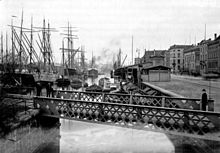Holsten Bridge
Coordinates: 53 ° 51 ′ 59 ″ N , 10 ° 40 ′ 50 ″ E
| Holsten Bridge | ||
|---|---|---|
| Convicted | Trave | |
| place | Lübeck old town | |
| opening | 1854/1934 | |
| location | ||
|
|
||
The Holstenbrücke is a bridge in Lübeck's old town .
location
The Holsten Bridge spans the Trave at the western end of Holstenstrasse and leads to the Holsten Gate . It is not an independent street, but is already part of Holstentorplatz . The bridge structure marks the border between the upper (southern) and lower (northern) part of the city trave. Historically, the Holsten Bridge formed the connection between the original (inner) Holsten Gate, which was located on the city-side bank of the river, and the gate building on the opposite bank of the Trave, which was first mentioned in 1366. Until the construction of the swing bridge, bought second-hand in Scotland by the thrifty city fathers of Lübeck, in 1892, it remained the northernmost crossing of the Trave in Lübeck.
history
A bridge that led across the Trave in front of the inner Holsten Gate is first documented in written sources from 1216. When it was erected and what shape it was is not known; presumably it was a typical wooden bridge with a hinged middle section. On November 4, 1320, it was destroyed by a storm flood and had to be replaced by a new stone building. It is possible that the Holsten Bridge was rebuilt together with the inner Holsten Gate as early as 1376, as reports of the diversion of road traffic over a pontoon bridge below the Becker pit in connection with the construction work on the gate .
On July 18, 1500, the Holsten Bridge collapsed and was rebuilt. The execution was probably flawed, because as early as 1516 it was so damaged that a complete new building was necessary. As the council builder had visited Nuremberg's public buildings three years earlier on a business trip that had been set up especially for this purpose , he was given the task of building the new Holsten Bridge based on the Nuremberg model. An arched bridge with a steep hunching in the middle was built with four arches, of which the third, designed as a pointed arch , was the largest when viewed from the city. In the older literature there is still the statement that the Holsten Bridge from 1516 was built on the model of a Nuremberg bridge, which in turn was modeled on the Rialto Bridge in Venice . However, this is incorrect, as the Rialto Bridge was only built between 1588 and 1591.
Extensive repair work was necessary in 1578, the pillars had to be replaced between 1632 and 1634, and then the arches in 1686. Other major work took place between 1821 and 1849.
In the 19th century, the Holsten Bridge increasingly proved to be a hindrance. Ludwig Ewers ' protagonists in his Lübeck novel Die Großvaterstadt go into that "annoyance" as well as that of the eye of the needle at the mill bridge . Because of the steep incline on both sides and the hump in the middle, it was a serious and dangerous obstacle for wagons, and it was too narrow for the increasing traffic after the opening of the station in front of the Holsten Gate. In 1853 it was therefore canceled. The street level on both banks was raised by backfilling and a new bridge was built in 1854, which spans the Trave with a single large arch without any central elevation. With the construction of the Lübeck railway , a girder bridge with a railway track was added on the north side, which served to develop the Lübeck port on the Untertrave . Using a turntable on each side of the bridge, the wagons were turned individually by 90 ° so that the bridge could only be passed by wagon. This cumbersome handling was not necessary until the swing bridge was put into operation.
In the 20th century, this bridge also proved to be too narrow for the increasing volume of traffic. In 1934 it was widened on both sides as a girder bridge in the course of the redesign of the Holstentorplatz and received its present appearance; the core of the bridge from 1854 was retained.
literature
- Hanseatic City of Lübeck (ed.): The architectural and art monuments of the Hanseatic city of Lübeck. Volume I, Part 1: City plans - views, city fortifications, water arts and mills . Bernhard Nöhring publishing house, Lübeck 1939
- Rainer Andresen: The old townscape. Volume 1: History - Churches - Fortifications . Verlag Neue Rundschau, Lübeck




